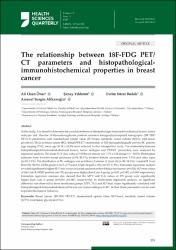| dc.contributor.author | Öner, Ali Ozan | |
| dc.contributor.author | Yıldırım, Şenay | |
| dc.contributor.author | Sürer Budak, Evrim | |
| dc.contributor.author | Sezgin Alikanoğlu, Arsenal | |
| dc.date.accessioned | 2023-11-13T08:56:09Z | |
| dc.date.available | 2023-11-13T08:56:09Z | |
| dc.date.issued | 2023 | en_US |
| dc.identifier.citation | Öner, A. O., Yıldırım, Ş., Budak, E. S., & Alikanoğlu, A. S. (2023). The relationship between 18F-FDG PET/CT parameters and histopathological-immunohistochemical properties in breast cancer. HEALTH SCIENCES QUARTERLY, 3(4), 259-268. | en_US |
| dc.identifier.issn | 2791-6022 | |
| dc.identifier.uri | https://dx.doi.org/ 10.26900/hsq.2122 | |
| dc.identifier.uri | https://hdl.handle.net/20.500.12933/1719 | |
| dc.description.abstract | In this study, it is aimed to determine the correlation between histopathologic-immunohistochemical factors, tumor subtypes and fluorine-18-fluorodeoxyglucose positron emission tomography/computed tomography (18F-FDG PET/CT) parameters such standardized uptake value (SUVmax), metabolic tumor volume (MTV), total lesion glycolysis (TLG) in breast cancer (BC). Initial PET/CT examination of 110 histopathologically proven BC patients (age ranging 27-92, mean age 56.18 ± 14.59) were included in this retrospective study. The relationship between histopathological-immunohistochemical factors, tumor subtypes and PET/CT parameters were analyzed by regression analysis. The mean SUV max value of 110 breast tumors was 7.73 ± 5.62 (range 1.4 - 34.15). Histological subtypes were; invasive ductal carcinoma (n:94, 85.5%), invasive lobular carcinoma (n=6, 5.5%) and other types (n=10, 9.1%). The distribution of BC subtypes was as follows; Luminal A (Lum A) (n=38; 34.5%), Luminal B (Lum B) (n=56; 50.9%), HER2-positive (n=3; 2.7%) and Triple Negative (TN) (n=13; 11.8%). Univariate regression analysis revealed significantly higher SUV max values in ductal carcinomas than lobular carcinomas (p=0.03). SUVmax values of the Lum B, HER2 positive and TN groups were higher than Lum A group (p=0.03, p<0.001, p<0.001 respectively). Univariate regression analyses also showed that the MTV and TLG values of TN group were significantly higher than Lum A group (p=0.011, p=0.007, respectively). In multivariate regression analyses, no significant difference was observed in above mentioned groups. MTV, TLG and SUVmax values significantly correlated with histopathological-immunohistochemical factors and tumor subtypes in BC. So that, these parameters can be used to predict the tumors’ behavior. | en_US |
| dc.language.iso | eng | en_US |
| dc.publisher | Holistence Publications | en_US |
| dc.relation.isversionof | 10.26900/hsq.2122 | en_US |
| dc.rights | info:eu-repo/semantics/openAccess | en_US |
| dc.subject | Breast Cancer | en_US |
| dc.subject | 18F-FDG PET/CT | en_US |
| dc.subject | Standardized Uptake Value (SUVmax) | en_US |
| dc.subject | Metabolic Tumor Volume (MTV) | en_US |
| dc.subject | Total Lesion Glycolysis (TLG) | en_US |
| dc.title | The relationship between 18F-FDG PET/CT parameters and histopathological-immunohistochemical properties in breast cancer | en_US |
| dc.type | article | en_US |
| dc.authorid | 0000-0001-7487-9044 | en_US |
| dc.department | AFSÜ, Tıp Fakültesi, Dahili Tıp Bilimleri Bölümü, Nükleer Tıp Ana Bilim Dalı | en_US |
| dc.contributor.institutionauthor | Öner, Ali Ozan | |
| dc.identifier.volume | 3 | en_US |
| dc.identifier.issue | 4 | en_US |
| dc.identifier.startpage | 259 | en_US |
| dc.identifier.endpage | 268 | en_US |
| dc.relation.journal | Health sciences quarterly (Online) | en_US |
| dc.relation.publicationcategory | Makale - Ulusal Hakemli Dergi - Kurum Öğretim Elemanı | en_US |
















